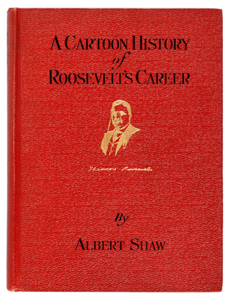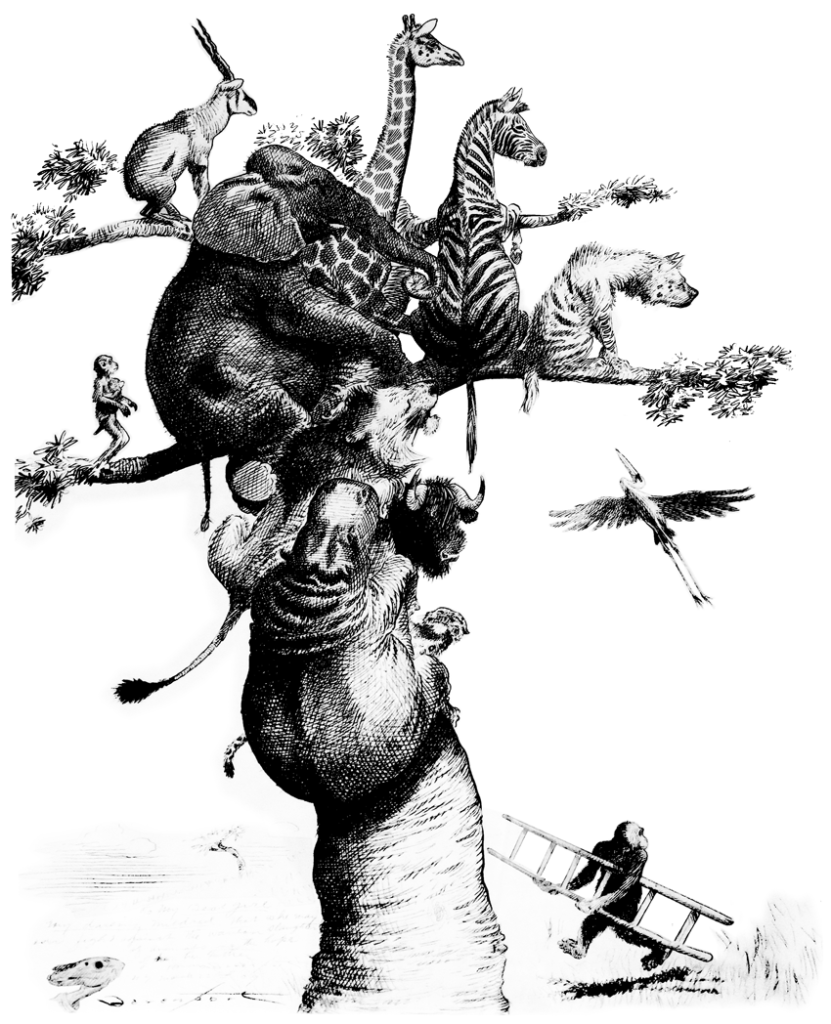Several years ago, I encountered a book from 1910 titled “A Cartoon History of Roosevelt’s Career” by Albert Shaw. Knowing how many of Davenport’s cartoons depicted Colonel Roosevelt, I naturally assumed that it would contain at least a couple. There turned out to be a total of ten Davenport cartoons. Several with Uncle Sam, including the famous “He’s Good Enough for Me” piece. And after he left Hearst’s employ, he never used the “Rough Rider” trope employed by many of his contemporaries.
But one cartoon attracted my attention more than any other, as it did not include Roosevelt at all. It showed a barren leafless tree, filled up with a multitude of different African animals. A monkey with a ladder running towards the tree was the only critter left on the ground. The caption was “HIST! Looks Who’s Coming.” It was published in the New York Mail on March 12, 1909, and was referencing Roosevelt’s much publicized post-presidential extended safari to Africa.
The detail of the animals was quite striking (below). Each could easily be identified with its real-life counter parts, (aside from the three monkeys, who were depicted anthropomorphically). Like so many of Davenport’s originals, its fate was unknown.
Until I received and email from Tania from the Digital History Projects Staff of the Oregon Historical Society. She had been contacted by a gentleman from South Carolina that wanted to contact any Davenport family members to see if he could sell the original of that very same piece. He had financial issues, and decided to sell the original, but wanted to contact the family first. I put him in contact with Homer Davenport’s great-granddaughter, Jill, who resides in Seattle. It turned out that it had a hand-written dedication by Homer to his eldest daughter Mildred, Jill’s grandmother. The inscription for this piece reads:
“To my Best Girl, my darling Mildred, that she may ever fight against the wanton slaughter of animals is the hope of her father.” [Signed] Homer Davenport, N.Y. March 22, 1909. Just ten days after it was published. Despite the implied “wanton slaughter” comment, Homer and Colonel Roosevelt remained close friends until his death in 1912. The asking price was too much for them, so they passed. I made a counter offer myself, but he had found another collector from Boston who agreed to the original price.
Several months later, I received an email from the South Carolinian, who recounted how the other collector turned out to be a scam artist, and he had to have law enforcement involved to get the cartoon back. He asked if I was still interested, and within a week, the 3 by 2-and-a-half foot framed “Look Who’s Coming” arrived in Silverton! It joins the other Davenport originals in the collection of the Silverton Country History Museum.
Researching this cartoon revealed the following statement made by Davenport in reply to what he considered to be his best work:
“There was a time when I thought ‘He’s Good Enough for Me’ was the best thing I ever drew, but while it may be the most widely circulated cartoon ever printed, owing to the poster work it served for the Republican National Committee, yet it was not a great cartoon by any means. At other times I think some of the cartoons of mine used in the 1897 campaign were prize winners, and still at other times I think some of the reform cartoons are superior to any others of my creation. So it goes. However, I take a chance and send you what I now consider my best bit of work, ‘See Who’s Coming,’ printed on the day Roosevelt sailed for Africa. I may change my mind next week, but this one right now appeals more strongly to me than does any other one I ever have made.” – September 12, 1909
Additionally, I stumbled upon this short, 30 second animated film, (below) on the Library of Congress website which was obviously inspired by this very same cartoon! In it, the monkey on the ground jumps up and down excitedly, and runs up the tree, as a smallish dot appears in the distance, growing closer. It finally comes up over the hill as a smiling “Teddy Roosevelt” with a rifle. The animator is unknown and lost to history. This was less than five years before Winsor McCay’s ground-breaking 1914 hand-drawn animated classic, “Gertie the Dinosaur.”

